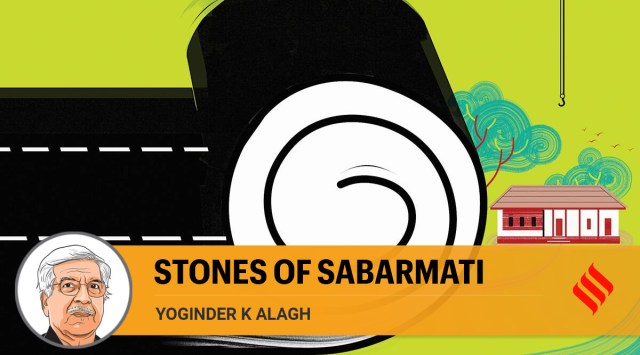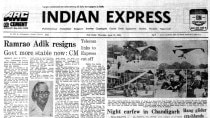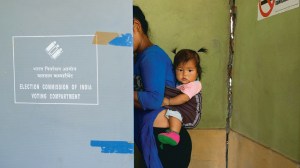- India
- International
Each stone of Sabarmati Ashram speaks of history. What will happen when it’s redeveloped?
Yoginder K. Alagh writes: The nation must respect its heritage, for it embodies its memories.
 We must learn to treasure the stones, each one of which will remind us of their “memory”. (Illustration: C R Sasikumar)
We must learn to treasure the stones, each one of which will remind us of their “memory”. (Illustration: C R Sasikumar)Stones speak to you, unless you are the Taliban destroying the Bamiyan Buddhas with barbaric vengeance. The recent decision to build new structures in the IIM-A, because the corridors are dark and cold, took me back to the mid-Sixties when I was teaching and finishing my thesis at the University of Pennsylvania at Philadelphia. One day, Louis Kahn called all of us — Indian students and teachers — to the School of Architecture. In his dramatic style, he stood in front of a silk curtain behind which we could see a light. He dramatically parted the curtain and we saw the model of the IIM-A. He asked: “First impression?”
I was in the first row and he asked me: “Do you know Ahmedabad?” I said: “Yes sir”. He said: “So?” I blurted out: “It is very un-Indian.” He was infuriated. “What do you mean?” he asked. I knew I was in a soup. I said, “Mine is a poor country. These give a sense of power.” He looked at me, stammered and said: “No. It’s a monastery.” I retired hurt.
In Ahmedabad, the Sabarmati was once a river. Bapu’s ashram was on its banks. When I had a headache on account of all my worldly care — running institutions from a relatively young age — I would go to Hriday Kunj, sit for a few minutes, see his spectacles, writing desk and slippers, feel he was mocking me for trivialising life (“Look at my problems young man,” his twinkling eyes said).
I went to the river bank, sat for a while, felt happy again, walked back, ate puri/shak at the cafeteria and went back.
Then there were the riots in March 2002. Chuni Kaka (the Gandhian, Chuni Vaidya) called up to say that he and Narayan Desai were going on a silent march, with a black gag on their mouth, from the Kochrab Ashram to the Sabarmati Ashram, carrying a poster, “Ahmedabad wants peace”. “Would you like to join?” Of course, I will, I said. My son joined too. We were around 40 people to begin with. Ahmedabad was still burning. We didn’t have police protection. But people kept on joining and half way, at the Gujarat Vidyapith set up by Bapu, there were hundreds marching. Log saath aate gaye aur carvaan banta gaya. At the ashram, a message of peace was read out, in spite of my protest, in my name — and not Vaidya’s or Desai’s. It was reported the world over.

Many years later, I was to lead the Indian delegation to the first Indo-Pak Planning Commission meeting. At Takshila, the stones speak to you, although the official guide gave it an “Islamic” twist, ignoring my diplomatic demurring, which he dismissed as anti-Islamic propaganda. Later at Nalanda, the stones whispered the same stories.
Meanwhile, Bimal Patel, whose teacher, the American planner of Spanish origin, Manuel Castells, had once invited me to a select meeting of experts to brief the first Prime Minister of Spain after the fall of the Franco regime, gave me a lowdown on his plans for redevelopment of the riverfront. I told him not to plan with a 10-year flood history, and sure enough, crores of rupees of work were washed away in the next monsoon flood. During this briefing, I also muttered something about my friend, the architect Charles Correa, and that he had not spoiled the Ashram while redoing it. I shudder at the redevelopment now.
At JNU, the stones speak to you in your morning walk. The Aravalli ranges there are short of water. The Rohillas ran away because of thirst. I wasn’t going to run away. So, I got satellite imagery to help us to decide where to dig for water. While planning the Sardar Sarovar dam, we had to dig the foundations to withstand a thousand-year flood.
And now they want to turn the room where Nehru stood up on the midnight of August 14, 1947 and addressed the world — “When the world sleeps, India will awake to life and freedom” — into a museum. There are such rooms in other countries. Nations treasure their heritage. We are the descendants of Pataliputra. My ancestors include Raja Porus, Prithviraj Chauhan, the persecuted Bahadur Shah Zafar. The Dandi March is my heritage.
The redevelopment of Gandhiji’s birthplace in Porbandar destroyed its simple elegance. A few decades ago, a narrow road led to his three-storied brick-and-stone house. There was peace on each floor. You sat there, happy at the journey you had made. Now the gali is widened. The shops are gone. The house has been “redeveloped”. It’s sickening if you compare it with the earlier ambience.
We must learn to treasure the stones, each one of which will remind us of their “memory”.
This column first appeared in the print edition on September 13, 2021 under the title ‘Stones of Sabarmati’. The writer is an economist and a former Union minister.
EXPRESS OPINION
More Explained
Apr 20: Latest News
- 01
- 02
- 03
- 04
- 05










































